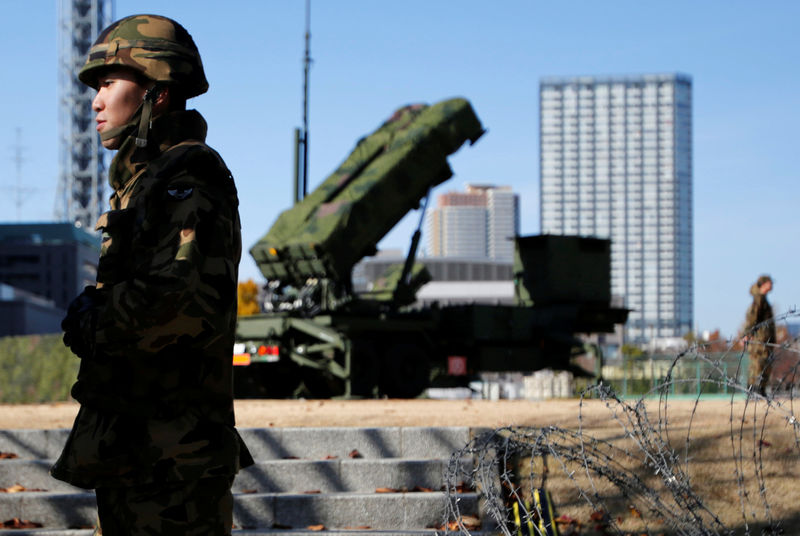By Tim Kelly and Nobuhiro Kubo
TOKYO (Reuters) - Japan is upgrading its Patriot PAC-3 missile defense system in time for the 2020 Tokyo Olympic Games, adding range and accuracy needed to intercept more advanced North Korean ballistic missiles, four sources with knowledge of the plan said.
The move represents the most significant upgrade to Japan's missile defense system in a decade and is part of an increase in military spending in the region, where geopolitical tensions are rising.
The rollout of the new advanced Missile Segment Enhancement, which could double the range of the current PAC-3 missiles to around 30 km (19 miles), will likely start next year, said the sources, who were not authorized to speak publicly about the project.
"The upgraded PAC-3 is necessary to counter the Musudan," said one source, referring to Pyongyang's intermediate-range ballistic missile.
North Korea in June test-fired what appeared to be two Musudan rockets. The first failed, but the second traveled 400 km (250 miles), more than halfway towards the southwest coast of Japan and reached a height of 1,000 km - enough altitude to give its warhead a range of more than 3,000 km (1,800 miles).
Experts said that test represented a technological advance for the Pyongyang regime, which is also developing nuclear weapons.
It puts it one step closer to being able to lob a warhead that could plunge to its target at speeds of several kilometers a second, potentially too fast for the current PAC-3 batteries that are the last line of defense against missile strikes.
South Korea's military operates the older PAC-2 system and has a program to replace it with the PAC-3 system by 2018, a South Korean defense ministry official said. U.S. forces based in the country were also planning to upgrade their PAC-3 batteries covering the capital Seoul, the official added.
RISING TENSIONS
Along with North Korea's missile and nuclear tests, tensions in Asia are being fueled by ongoing territorial disputes between China and Japan in the East China Sea, and between China and several Southeast Asian nations in the South China Sea.
China is swiftly modernizing its armed forces, in part to counter what it sees as a strategy of containment in the United States' Asian "pivot".
A spokesman for Japan's Defence Ministry said "nothing has been decided" on the PAC-3 upgrade.
The International Olympic Committee's decision to grant Tokyo the 2020 games will help unlock funding for the PAC-3 upgrade despite military budget constraints, the sources told Reuters.
Around 100 billion yen ($955 million) in funding would be requested in the next defense budget proposal for the year starting April 2017, one of the sources said. Funding will need cabinet approval before going into the national budget and additional funds would have to be approved for subsequent years.
Japan is also considering purchasing the advanced Terminal High Altitude Area Defense, or THAAD, anti-missile system, which Washington and Seoul agreed to deploy in South Korea earlier this month. That decision sparked a complaint from China, which said it would destabilize the regional security balance.
The Patriot upgrade would likely be an enhancement to Japan's ballistic missile defense, rather than an alternative to THAAD or a similar system.
Japan also has Aegis-equipped destroyers patrolling the Sea of Japan that are loaded with interceptor missiles designed to hit incoming projectiles. It is currently developing a new version dubbed the Standard Missile 3 (SM-3) with the United States designed to destroy ballistic warheads in space, although no decision on a roll out has yet been made.
The PAC-3 system was developed by Lockheed Martin Corp (NYSE:LMT) and Raytheon Co. Japan's biggest defense contractor, Mitsubishi Heavy Industries (MHI), will begin work on Japan's systems under license after April next year, the sources said.
MHI will upgrade 12 batteries in the first year, another 12 the following year with four in the subsequent twelve months, the sources said. Those guarding the Tokyo area will take priority and some used for training will not be upgraded.
"The Ministry of Defence has not made any announcement regarding this, so as a commercial company we are not in a position to comment," a MHI spokeswoman said.
Raytheon did not immediately respond to a request for comment, while a Lockheed spokeswoman said the company had "a long and successful history of working with Japanese industry in their production of the PAC-3 missile system under license”.
